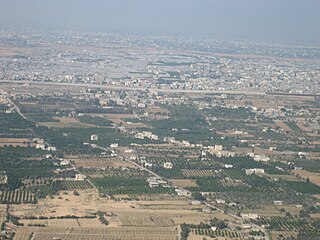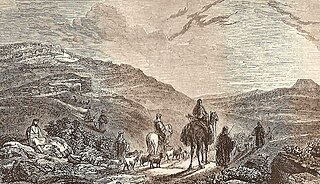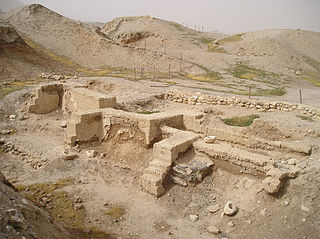Related Research Articles

Jericho is a city in the West Bank, Palestine; it is the administrative seat of the Jericho Governorate of Palestine. Jericho is located in the Jordan Valley, with the Jordan River to the east and Jerusalem to the west. In 2017, it had a population of 20,907.
Camps are set up by the United Nations Relief and Works Agency (UNRWA) in Jordan, Lebanon, Syria, the West Bank and the Gaza Strip to accommodate Palestinian refugees registered with UNRWA, who fled or were expelled during the 1948 Palestinian expulsion and flight after the 1948 Arab–Israeli War or in the aftermath of the Six-Day War in 1967, and their patrilineal descendants. There are 68 Palestinian refugee camps, 58 official and 10 unofficial, ten of which were established after the Six-Day War while the others were established in 1948 to 1950s.

The 74th (Yeomanry) Division was a Territorial Force infantry division formed in Palestine in early 1917 from three dismounted yeomanry brigades. It served in the Sinai and Palestine Campaign of the First World War, mostly as part of XX Corps. In May 1918 it was sent to the Western Front where it remained until the end of the war.

Rafah is a Palestinian city in the southern Gaza Strip. It is the capital of the Rafah Governorate of the State of Palestine, located 30 kilometers (19 mi) south-west of Gaza City. In 2017, Rafah had a population of 171,889. As a result of massive bombardment and ground assaults in Gaza City and Khan Yunis by Israel during the Israel–Hamas war, about 1.4 million Palestinians are believed to be sheltering in Rafah as of February 2024.

Hilarion the Great (291–371) was an anchorite who spent most of his life in the desert according to the example of Anthony the Great (c. 251–356). While Anthony is considered to have established Christian monasticism in the Egyptian Desert, Hilarion is considered by some to be the founder of Palestinian monasticism and venerated as a saint by the Orthodox and the Roman Catholic Church.

Deir al-Balah or Deir al Balah is a Palestinian city in the central Gaza Strip and the administrative capital of the Deir al-Balah Governorate of the State of Palestine. It is located over 14 kilometers (8.7 mi) south of Gaza City. The city had a population of 75,132 in 2017. The city is known for its date palms, after which it is named.
Deir al-Balah Camp is a Palestinian refugee camp in the Deir al-Balah Governorate of the southern Gaza Strip, located one kilometer northwest of the center of Deir al-Balah city, of which it practically forms part. The camp consists of concrete buildings and has eight schools, sewers, and other municipal services. According to the Palestinian Central Bureau of Statistics, the camp had a population of 6,985 in 2017. It is the smallest refugee camp in the Gaza Strip. Deir al-Balah Camp is built on an area of 0.16 square kilometers. As of March 2005, the population registered with the United Nations Relief and Works Agency (UNRWA) was 19,534 persons.

Teqoa is a Palestinian town in the Bethlehem Governorate, located 12 km (7.5 mi) southeast of Bethlehem in the West Bank. The town is built adjacent to the biblical site of Tekoa (Thecoe), now Khirbet Tuqu', from which it takes its name. Today's town includes three other localities: Khirbet ad-Deir, al-Halkoom, and Khirbet Teqoa. According to the Palestinian Central Bureau of Statistics (PCBS), Teqoa had a population of 8,767 in 2017.

Levantine archaeology is the archaeological study of the Levant. It is also known as Syro-Palestinian archaeology or Palestinian archaeology. Besides its importance to the discipline of Biblical archaeology, the Levant is highly important when forming an understanding of the history of the earliest peoples of the Stone Age.

The following outline is provided as an overview of and topical guide to the State of Palestine:

Nuseirat is a Palestinian refugee camp located in the middle of the Gaza Strip, five kilometers north-east of Deir al-Balah. The refugee camp is in the Deir al-Balah Governorate, Gaza Strip. According to the Palestinian Central Bureau of Statistics, the refugee camp had a population of 31,747 and the surrounding Nuseirat municipality had a population of 54,851 in 2017.

Gaza Sanjak, known in Arabic as Bilād Ghazza, was a sanjak of the Damascus Eyalet, Ottoman Empire centered in Gaza, northwards up to the Nahr al-‘Awja/the Yarkon River. In the 16th century it was divided into nawahi : Gaza in the south and Ramla in the north along the Nahr Rūbīn/Wādī al-Ṣarār.

Tell es-Sakan, lit. "Hill of Ash", is a tell about 5 km south of Gaza City in what is today the Gaza Strip, on the northern bank of Wadi Ghazzeh. It was the site of two separate Early Bronze Age urban settlements: an earlier one representing the fortified administrative center of the Egyptian colonies in southwestern Palestine from the end of the 4th millennium, and a later, local Canaanite fortified city of the third millennium. The location at the mouth of what was probably a palaeochannel of the river, allowed it to develop as an important maritime settlement with a natural harbour. Its geographical location endowed it with a position of importance at the crossroads of land-based trade routes between the Canaan region, the Old Kingdom of Egypt, and Arabia. As of 2000, the early Egyptian settlement was the oldest fortified site known to researchers in both Egypt and Palestine.

Dayr 'Amr was a Palestinian Arab village in the Jerusalem Subdistrict. It was depopulated during the 1948 Arab-Israeli War on July 17, 1948, by the Fourth Battalion of the Har'el Brigade, during the second stage of Operation Dan. It was located 12.5 km west of Jerusalem. Dayr 'Amr was named after a local sage known by al-Sa'i 'Amr and a shrine was in the village dedicated to him.
The Palestine Technical College is a college in Deir El-Balah, Gaza Strip, Palestine. The college offers bachelor degree programs and 2-year associate degrees in technical education at the post-secondary level, as well as programmers for different target groups through continuing education.
Saint Hilarion Monastery, at the archaeological site of Tell Umm el-'Amr, is an ancient Christian monastery close to Deir al-Balah in the Gaza Strip, Palestine.

Jamila Ahmed Khamis Saidam, also known as Umm Sabri, was a Palestinian politician. She was one of the first group of women elected to the Legislative Council in 1996.
References
- ↑ Rami K. Isaac, C. Michael Hall, Freya Higgins-Desbiolles. The Politics and Power of Tourism in Palestine. Routledge. pp. 137–148. ISBN 9781138592285.
{{cite book}}: CS1 maint: multiple names: authors list (link) - ↑ Elter, René; Hassoune, Ayman (1 January 2008). "Le complexe du bain du monastère de Saint Hilarion à Umm el-'Amr, première synthèse architecturale". Syria. Archéologie, art et histoire (in French). pp. 129–144. doi:10.4000/syria.474.
- ↑ "Tell Umm El-'Amr (Saint Hilarion Monastery)". World Monuments Fund. Retrieved 2023-11-29.
- 1 2 mondial, UNESCO Centre du patrimoine. "Tell Umm Amer". UNESCO Centre du patrimoine mondial (in French). Retrieved 2023-11-29.
- ↑ "Sauver Saint-Hilarion à Gaza, le plus vieux monastère de Terre sainte". Le Point (in French). 2013-06-04. Retrieved 2023-11-29.